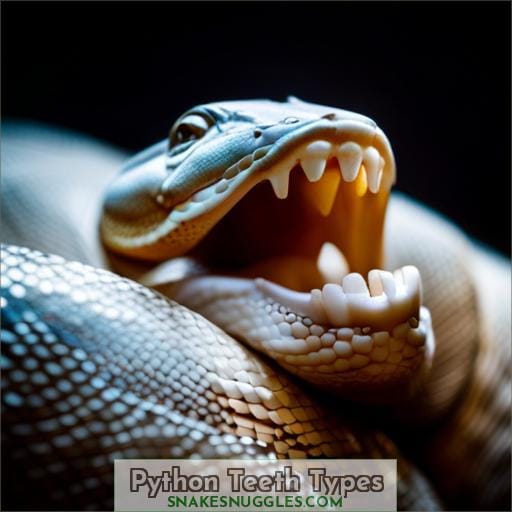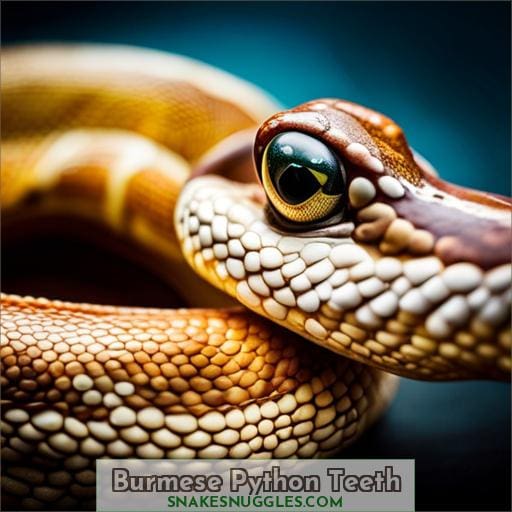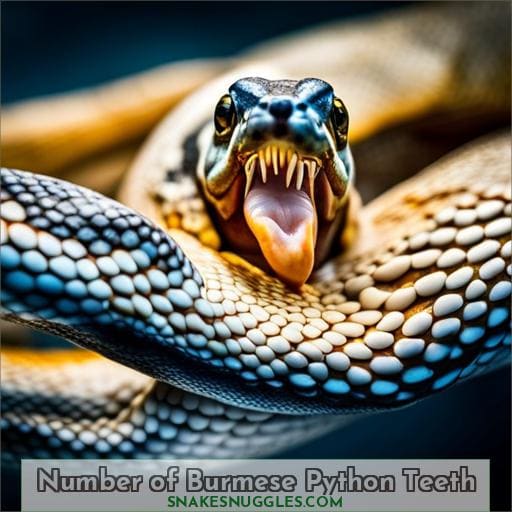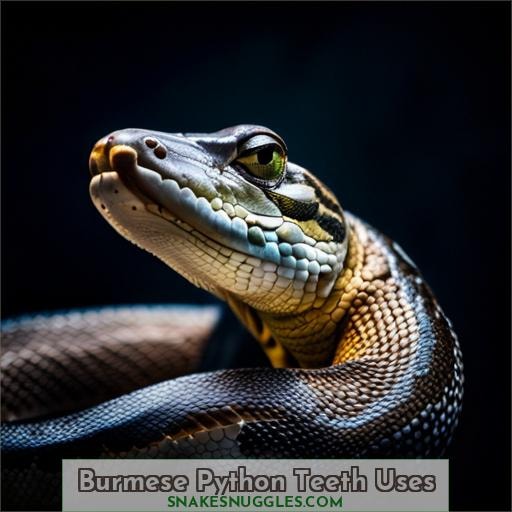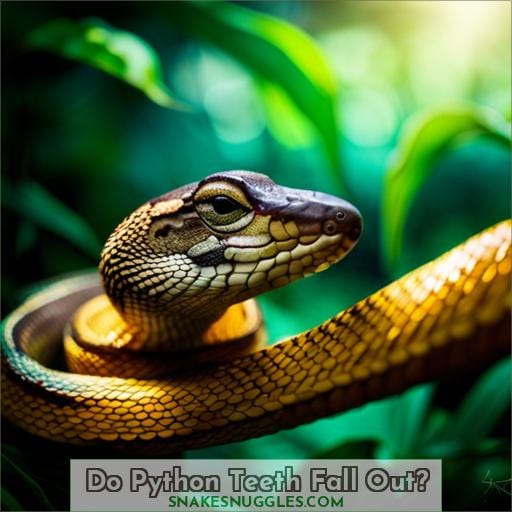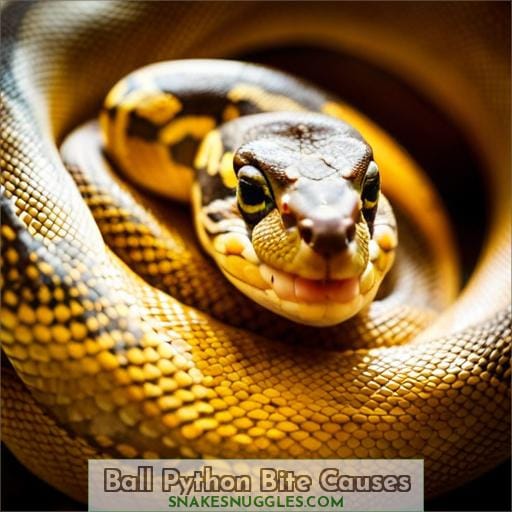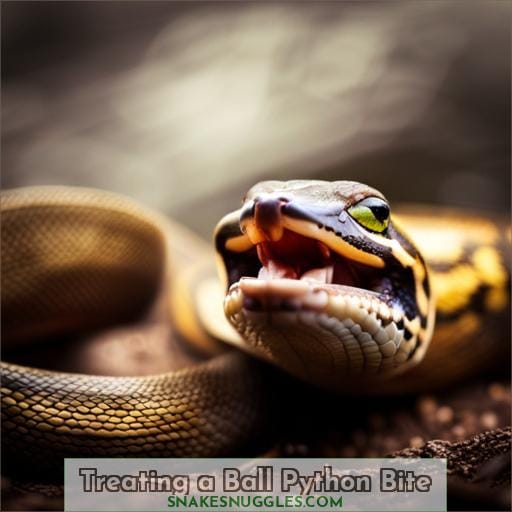This site is supported by our readers. We may earn a commission, at no cost to you, if you purchase through links.

But have you appreciated the power of a python’s bite?
With rows of inward curving teeth, they can inflict deep puncture wounds.
Though nonvenomous, their bite means business.
Whether constricting prey or defending themselves, a python’s teeth enable a tenacious grip.
So admire their graceful glide, but beware the formidable fangs within.
Table Of Contents
- Key Takeaways
- Python Teeth Types
- Burmese Python Teeth
- Number of Burmese Python Teeth
- Burmese Python Teeth Uses
- How Burmese Pythons Hunt With Teeth
- Do Python Teeth Fall Out?
- Can Pythons Bite Humans?
- Are Python Bites Dangerous?
- Ball Python Bite Causes
- Treating a Ball Python Bite
- Frequently Asked Questions (FAQs)
- Conclusion
Key Takeaways
- Pythons have rows of small, sharp, curved teeth used for firmly grasping prey and inflicting damage.
- Burmese pythons possess 80-120 razor-sharp, backward-curving teeth evolved to maximize damage on prey.
- Python teeth are constantly developing and shedding; their impressive dental anatomy aids hunting and defense.
- Ball pythons may bite defensively or when hunting; bites can result from stress, hunger, or mistaken identity.
Python Teeth Types
You’ve got the three fang types:
- Solenoglyphous with a single hollow tube for venom,
- Proteroglyphous with fangs at the front of the mouth,
- And opisthoglyphous with fangs at the rear of the jaws.
Pythons lack these specialized fangs and venom, instead possessing rows of small, recurved teeth for grasping prey.
Their teeth angle inward, allowing pythons to secure a firm hold on captured animals.
Though nonvenomous, python bites can still inflict injury through punctures, lacerations, or even potential bacterial infection if the wound goes untreated.
When threatened, pythons may bite defensively, using their sharp teeth to puncture skin.
But they lack any venom, instead relying on constriction to subdue prey during hunting.
Proper handling technique helps minimize defensive biting.
Burmese Python Teeth
Burmese pythons possess sharp, curved teeth ideal for biting and gripping prey.
These snakes rely on their rows of razor-sharp teeth to hunt effectively.
The teeth allow Burmese pythons to latch onto prey and prevent escape once they attack, much like their constriction hunting techniques used on small mammals and birds
.
Sharp and Curved Inward
But you should know that Burmese pythons have razor-sharp teeth, which are bent or curved inward.
They can easily pierce prey flesh, causing immense pain if they sink into human skin when threatened.
Their backward-curved teeth enable a strong, painful bite.
Cause Pain When Biting
Their teeth cause great pain when they sink in and drag deeper when retracted.
Burmese pythons use their teeth primarily for defense and hunting, so their powerful bites evolved to inflict maximum damage on prey and threats.
Still, understanding their body language helps prevent startling defensive bites.
Enable Strong Bites
With your strong teeth enabling powerful bites, you’ve evolved as an effective predator.
Backward-curving teeth enable a strong grip on prey.
Multiple rows allow you to lock onto struggling prey.
Teeth pierce deeply when constricting, killing prey faster.
Your bite force has adapted for hunting and defense.
Sharp fangs puncture prey easily, making you an apex predator.
Number of Burmese Python Teeth
Burmese pythons have between 80 and 120 teeth.
As ectotherms that continue growing throughout life, their teeth are constantly developing, erupting, and falling out.
With multiple rows on the upper jaw and one on the lower, their impressive dental anatomy allows them to effectively grasp and anchor struggling prey.
By curling their muscular bodies around victims, they employ a ruthless constriction technique to restrain frantic movements.
Once prey is still, the python’s backward-curving teeth engage a brilliant prey lock mechanism so escape is impossible.
When threatened, these apex predators may exhibit an intense bite response.
Knowledge of their physiology facilitates appropriate handling and informed medical care after an unfortunate defensive encounter.
Burmese Python Teeth Uses
The primary purpose of the numerous sharp teeth of Burmese pythons is hunting. Their teeth enable them to effectively capture and kill prey through:
- Firmly grasping prey to prevent escape
- Inflicting deep puncture wounds
- Causing substantial blood loss
- Inducing shock through pain
In addition to hunting, their teeth may serve defensive purposes, such as warding off predators or humans.
However, Burmese pythons don’t actively hunt humans and primarily utilize their teeth for capturing natural prey within their native habitats.
Their specialized dentition indicates evolutionary adaptation for hunting success and survival in the wild.
How Burmese Pythons Hunt With Teeth
You use your sharp, backward-pointing teeth to ambush prey.
Lying motionless, you wait for an unsuspecting animal to wander by before swiftly striking, sinking your teeth in to prevent escape.
Your powerful jaws then begin constricting as your sharp teeth cause additional damage.
Your teeth are designed for gripping and tearing, not chewing.
You have two rows of teeth on your upper jaw and one row on your lower jaw.
Your teeth are constantly growing and being replaced.
You use your teeth to hunt, defend yourself, and hold onto prey.
You also use your teeth to groom yourself and your enclosure.
When hunting, you rely on your sharp teeth to grip and hold onto your prey.
Your powerful jaws then constrict, suffocating your prey.
You also use your teeth to defend yourself against predators.
If you feel threatened, you’ll strike out with your teeth and bite.
Do Python Teeth Fall Out?
Unlike your permanent teeth, a python’s teeth are routinely shed and replaced throughout its lifetime.
As snakes grow, their teeth fall out to make room for larger ones.
Pythons have a specialized tooth replacement cycle where a new tooth grows under the old one, eventually displacing it.
This tooth regeneration allows them to maintain functional dentition for hunting and defense even with the stresses of biting and killing prey.
Their dental anatomy and physiology are well-adapted to meet the demands of their predatory lifestyle.
| Tooth Type | Location | Number | Purpose |
|---|---|---|---|
| Fangs | Front of mouth | 2-6 | Venom injection |
| Needle Teeth | Sides of mouth | 60-100+ | Gripping prey |
| Molars | Back of mouth | 10-20 | Crushing bones |
Can Pythons Bite Humans?
As we’ve seen, pythons possess incredibly sharp, backward-pointing teeth that enable them to securely grasp prey.
Now, you may wonder – could these teeth be used against humans?
Indeed, large constricting snakes like pythons can deliver nasty bites if threatened or mishandled.
Though non-venomous, their long teeth can cause deep punctures and serious infections if untreated.
Avoid sudden movements, dangling hands/feet near enclosures, and grabbing snakes mid-body.
If bitten, immediately wash the wound with soap and seek medical care.
Applying antibacterial ointment and protective bandaging helps prevent complications.
Ultimately, respecting pythons’ space and proper handling reduces risk.
Are Python Bites Dangerous?
When a python bites you, the wound can be quite dangerous due to the risk of infection, tissue damage, and toxicity.
As experts in python biology, we rely on evidence to state that nonvenomous python bites pose little toxicity risk, but their sharp, curved teeth can cause deep puncture wounds and serious infections if left untreated.
Seek emergency care for severe swelling, numbness, nausea, or vision changes.
While pythons typically only bite when threatened, stressed, or feeding, even a defensive bite can introduce harmful bacteria deep into tissues and bones, requiring antibiotic treatment, wound cleaning, stitches, or even surgery.
When handling pythons, proper training in reading their body language helps prevent bites.
Overall, swift first aid and medical care helps mitigate the dangerous effects of infection from python bites.
We aim to promote safe, ethical python handling through education.
Ball Python Bite Causes
You must recognize that ball pythons typically only bite when feeling threatened or mistaking hands for prey.
These bites often occur if the snake is stressed from improper handling, disrupted shedding cycles, or confusing human scents with food sources.
Being attentive to their body language and enclosure conditions helps prevent unfortunate bites.
Defensive Strikes
When you mishandle your ball python, it may bite as a defensive reaction.
Observe its body language to prevent this.
If bitten, gently remove the snake while supporting its body.
Clean the wound thoroughly and seek medical attention for severe bites.
Handling techniques and behavioral cues aid prevention.
Prey-related Bites
Why do ball pythons bite when going after prey?
- Hunger drives hunting behavior.
- Mistaken identity if hands smell like food.
- Excitement when first noticing prey.
- Attempting to kill spotted prey.
- Constricting live prey with teeth.
You’re at risk of getting bit if you smell like their food or have just handled prey items.
Stress-induced Attacks
You’re also apt to get bitten when the snake feels stressed.
Behavioral triggers like improper handling and environmental factors can overwhelm them.
Utilize calm, efficient techniques focused on stress reduction to avoid triggering their reflexive coping mechanisms.
Treating a Ball Python Bite
- For minor bites, clean the area with soap and water, apply antibiotic ointment, and cover it with a bandage.
Watch for signs of infection like redness, swelling, pus, or fever.
- For more severe bites that break the skin, seek medical attention immediately.
Your doctor may prescribe antibiotics to prevent infection or recommend surgery if there’s tissue or nerve damage.
Getting prompt treatment reduces the risk of complications.
- Learn proper handling techniques like supporting the snake’s body and being aware of its body language.
Also, avoid handling after feeding and shedding.
Taking preventative measures reduces defensive bites.
Stay alert to the snake’s signals.
Frequently Asked Questions (FAQs)
Do ball pythons have fangs?
No, ball pythons do not have fangs.
Their small, inward-sloping teeth help them grasp prey but are not hollow for injecting venom like the fangs of venomous snakes.
Ball pythons kill prey by constriction, not venom.
What are the differences between venomous and non-venomous python teeth?
Let’s marvel at fangs, hollow injectors of venom, as pythons employ simple, solid teeth to grasp prey.
While vipers brandish hypodermic daggers, pythons wield short, rear-curved skewers to secure squirmy snacks.
Their modest armory suits a constrictor’s squeeze-and-swallow strategy.
Pythons lack venom, so basic dentition suffices to manage meals, not murder.
How frequently do pythons replace their teeth?
Pythons replace their teeth every 2-4 months.
As snakes grow, new teeth develop under old worn ones.
When ready, the old teeth fall out, and new sharp teeth take their place.
This tooth replacement cycle continues throughout a python’s life, ensuring their bite stays effective for hunting prey.
Do the sizes of python teeth vary?
The pythons’ teeth can measure up to 2 cm!
These carnivorous reptiles use their backward-curving teeth for hunting, grasping, and swallowing prey whole.
Their sharp, needle-like teeth enable them to seize and restrain victims during constriction.
Once prey is secured, pythons’ flexible jaws unhinge to consume large meals.
Can you tell the age of a python by examining its teeth?
No, you cannot determine a python’s age by examining its teeth. Their teeth are continuously replaced throughout life and do not correlate with age.
Focus instead on length, mass, and health markers for age approximation.
Conclusion
Gaze not into those glimmering eyes,
Lest the serpent strike!
For beneath the python’s sleek scales
Lie rows of needles eager for flesh.
Their fangs may lack venom,
But pack a piercing punch when provoked.
So admire their sinewy strength from afar,
And never underestimate the vice-like power of their bite.
For with one crushing clench,
A python’s teeth can make mincemeat of man.

